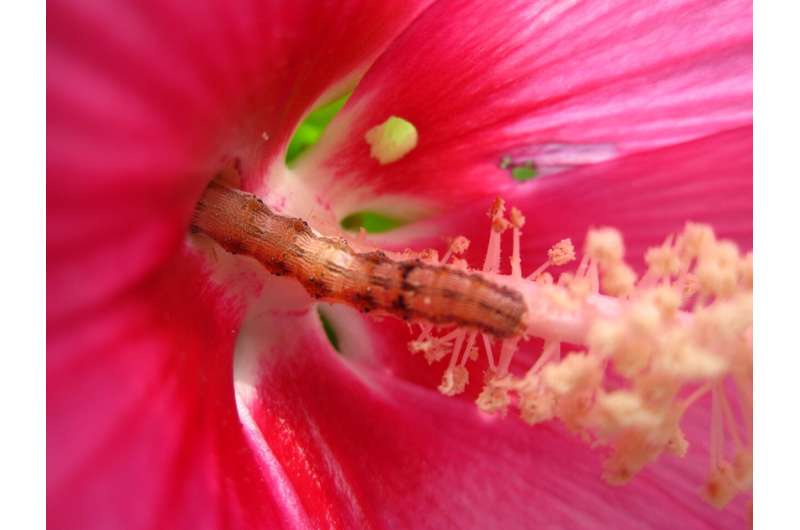This article has been reviewed according to Science X's editorial process and policies. Editors have highlighted the following attributes while ensuring the content's credibility:
fact-checked
peer-reviewed publication
trusted source
proofread
How a moth's taste preferences change with age

The larvae and adult forms of the cotton bollworm (Helicoverpa armigera) adopt different sugar-sensing systems to satisfy their requirements for food selection, according to new research.
Published today as a Reviewed Preprint in eLife, the study is described as important by the editors, who say it offers convincing evidence that two different gustatory receptors for sugar sensing underlie the change in diet preference between the larval and adult cotton bollworm.
The findings, combined with further research, could suggest a new approach for pest control to increase crop yields across the globe.
The cotton bollworm is a notorious, world-wide crop pest that contributes to approximately USD$3bn worth of economic loss every year. In its juvenile, larval stage the cotton bollworm mostly feeds on the leaves, flower buds and fruits of plants, which have a relatively low sugar concentration. As an adult, it mostly feeds on the sugar-rich nectar of plants.
Previous studies have shown that the cotton bollworm has external gustatory sensory neurons (GSNs)—specialized nerve cells responsible for detecting and transmitting taste signals to the brain—that are sensitive to sucrose and fructose. In larvae, these GSNs are located in specialized structures around their mouth, and in adults they are found in their antennae, the tarsi (the segments of the leg that are furthest from the body) and a specialized feeding structure called the proboscis, which serves a similar function as the human tongue.
"The larval and adult diets of the cotton bollworm vary dramatically in their variety and concentration of sugars. Sucrose is the major sugar found in plant tissues, whereas nectar mainly contains sucrose, fructose and glucose," explains lead author Shuai-Shuai Zhang, a Ph.D. student at the State Key Laboratory of Integrated Management of Pest Insects and Rodents, Institute of Zoology, Chinese Academy of Sciences, Beijing, China.
"We aimed to characterize the molecular basis for the change in diet seen between the cotton bollworm's two life phases."
Zhang and colleagues first compared the electrophysiological and behavioral responses of cotton bollworm larvae and adults to seven sugars found in plants, including sucrose, fructose and glucose. They confirmed that both larvae and adults have sugar-detecting GSNs, but that their response profile, intensity and sensitivity differed markedly.
The sugar GSNs in larvae responded strongly to sucrose with high sensitivity—between 100–1,000 times more sensitive to sucrose than adult GSNs, which responded to sucrose, fucose and fructose with lower intensity and sensitivity. This high sensitivity in larvae may help them locate sucrose in the sugar-sparse tissues of plants.
Next, the team analyzed the expression and function of nine candidate sugar gustatory receptor (GR) genes in larval and adult taste organs; Gr4–Gr12 inclusively. Since the function of Gr9 is known, they tested the function of other eight GRs using Xenopus oocytes—the underutilized eggs of the African clawed frog, which are widely used in scientific research as they are large and relatively easy to manipulate.
The team inserted DNA sequences for each GR gene into an individual oocyte, and then tested each oocyte's response to 11 different sugar compounds. Most oocytes had no response, but the oocytes expressing Gr10 and Gr6 were responsive to one or more sugars, indicating their role in food recognition. Gr10 was found to be tuned to sucrose specifically, whereas Gr6 responded to sucrose, fucose and fructose.
Finally, Zhang and colleagues used CRISPR/Cas9 DNA modifying techniques to create two homozygous mutants of cotton bollworms for Gr6 and Gr10, respectively—meaning they do not possess the function of the Gr6 or Gr10 gene any more.
The team sought to identify any changes in the electrophysiological and behavioral responses of the mutant larvae and adults to sugars compared to typical cotton bollworms. From their analysis, the team determined that Gr10 plays a key role in sucrose reception by the sugar GSNs in larvae, and mediates the larvae's preference for sucrose. On the other hand, Gr6 is responsible for sensing sucrose, fucose and fructose in the GSNs of the adult cotton bollworm.
Taken together, the results demonstrate that larval and adult cotton bollworms use different gustatory receptor genes to detect sucrose in food. Larvae mainly use Gr10 to detect the low amount of sucrose found in plant tissues, whereas adults primarily use Gr6 to detect a variety of sugars with high content, including sucrose in nectar.
Both the authors and the editors note that, to thoroughly reveal the mechanisms of sugar sensing to design a new approach for pest control, it is crucial to first comprehensively study the function of all of the GRs involved in sucrose sensation.
"We've reported the molecular basis of sucrose reception in the eternal taste neurons of the cotton bollworm, and discovered that different taste receptors underlie the difference in food selection between the adult and larval stages," concludes senior author Chen-Zhu Wang, a professor at the State Key Laboratory of Integrated Management of Pest Insects and Rodents, Institute of Zoology, Chinese Academy of Sciences.
"GRs closely associated with Gr10 and Gr6 are also found in other moth and butterfly species. We therefore speculate that similar sugar-sensing mechanisms may also exist in these species, which is worth verifying with future research."
More information: Shuai-Shuai Zhang et al, Sucrose taste receptors differ in larval and adult stages of a moth, eLife (2023). DOI: 10.7554/eLife.91711.1
Journal information: eLife
Provided by eLife



















